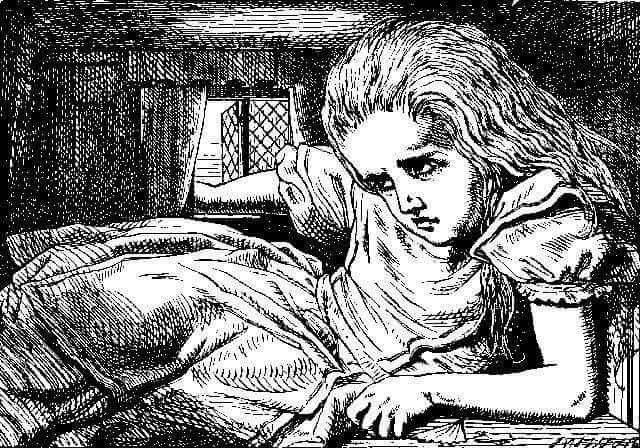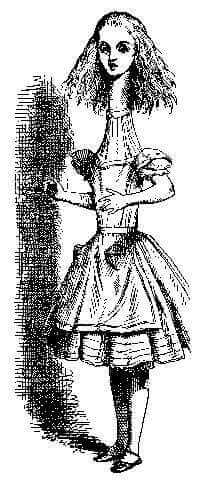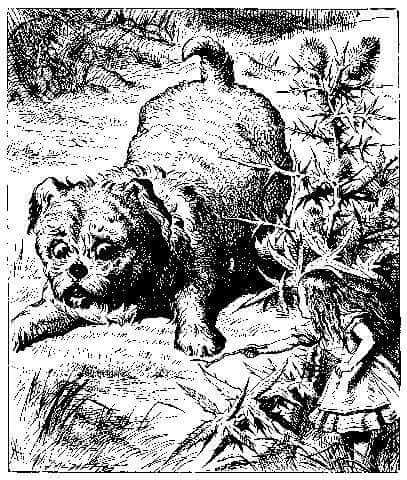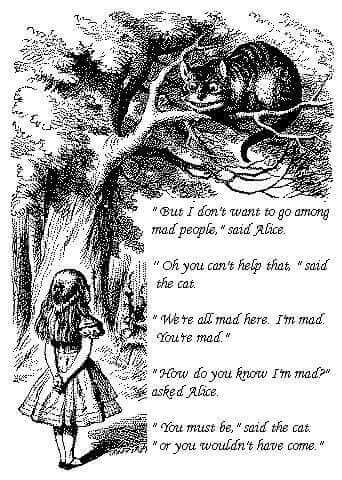Rayda Joomun
Mauritius
 |
| Diagram A: Total Macrosomatognosia |
Author Dedication
To Deelshad Reezuana,
The most beautiful Alice I met,
May you rest in peace in Wonderland…
“Thus grew the tale of Wonderland: / Thus slowly, one by one, / Its quaint events hammered out / And now the tale is done, / And home we steer, a merry crew, / Beneath the setting sun”¹
As a child, I got lost in the curious jargon and strange sequence of events in Alice’s Adventures in Wonderland. But more than that, I remember how scared and confused I was reading about Alice’s dangerous adventures, ludicrous bodily transformations, memory lapses, and the peculiar characters she met. I was relieved when she woke up from it all like a bad dream. “But was it really?” I could picture the Mad Hatter asking me, with the Cheshire Cat grinning from ear to ear, its body gradually fading away.
My mother experienced recurrent, episodic headaches with facial pain, nausea, and sensitivity to light, sound, and smell. She sometimes claimed that her eyes had grown out of proportion to the size of her face and she felt them popping out of their sockets. Painkillers and adequate sleep in a soundproof dark room would usually relieve her symptoms. We reassured her that her eyes were of normal size, not even slightly puffy. We thought she exaggerated her eye symptoms to get our attention, but little did we know that she had actually been experiencing Alice in Wonderland Syndrome, or AIWS.
Alice in Wonderland Syndrome is a disorientating neurological condition that affects the perception of vision, hearing, touch, sensation, and the phenomenon of time. Victims experience metamorphopsias, or changes in their perception of the size of objects or their own body parts.² It is a rare medical condition with unknown prevalence due to a lack of large scale studies and the absence of universally accepted diagnostic criteria. Caro Lippman first described the symptoms in 1952, with John Todd naming the condition in 1955.
 |
| Diagram B: Partial Macrosomatognosia |
Affected individuals experience diverse alterations in perception including micropsia (objects appear small), macropsia (objects appear large), teleopsia (objects appear further away than their real distance), pelopsia (objects appear closer than they are), and zoopsia (hallucinations of animals, especially swarms). They also have hallucinations or illusions of expansion, reduction, or distortion of their own body image. These include microsomatognosia, in which the individual feels part of the body shrinking, or macrosomatognosia, in which one feels the body or body parts growing inexplicably taller or larger. These have been termed Lilliputian hallucinations³. AIWS often overlaps with migraines. In fact it is considered to be an aura or migraine equivalent, particularly in children. Yet, people with AIWS also exhibit some anatomical changes that are distinct from others with migraine.
Lewis Carroll, also known as Charles Lutwidge Dogson, lectured in mathematics at Christ College, Oxford. While on a trip up the Thames River on July 4, 1862, with the daughter of the Vice Chancellor of Oxford University, Alice Liddell, and her two sisters, he narrated the story of a girl and her dream. Miss Lidell was so pleased that she implored him to immortalize it in writing for her. He presented the manuscript as a Christmas gift to her in 1865.
Many famous artists have experienced migraine including Pablo Picasso, Lewis Carroll, and Giorgio de Chirico. Their disease proved to be paradoxically beneficial to their art Alice In Wonderland is replete with signs of Carroll’s neurological plight. Carroll admitted to being a migraineur in The Carroll Diaries. He experienced “bilious headaches” with severe vomiting. In 1885 he wrote about “that odd optical affection of seeing moving fortifications followed by a headache.” Carroll consulted the distinguished ophthalmologist William Bowman about these visual disturbances.4
A separate diary entry from 1888 describes another episode: “Again experienced the optical fortifications. It began with a distinct loss of a large piece of the area of vision of the left eye, the blind patch being in the right hand corner, just where, directly afterwards, the fortifications appeared.” This is compatible with a right-sided paracentral negative scotoma, or visual field defect. In Mischmasch,5 a periodical Carroll often indulged in, he illustrated his visual problem. His character is missing parts of his left head and left upper limbs, which is consistent with the rounded border defect seen in a negative scotoma. His oculist did not seem to think that anything could be done about it at the time apart from avoiding eye strain.
Lewis Carroll dedicated two books to his heroine Alice: Alice’s Adventures in Wonderland (1865) and Through the Looking Glass (1871). Alice experiences countless peculiar feelings, namely a slowing in time perception while falling endlessly down the rabbit’s hole:
“Either the well was very deep, or she fell very slowly, for she had plenty of time as she went down to look about her and to wonder what was going to happen next.”6 (Diagram A)
 |
| Diagram C: Total Microsomatognosia |
 |
| Diagram D: Depersonalization |
Early in the second chapter, she shrinks after drinking from a bottle labeled “Drink Me.” Next her body grows so huge after eating a cake marked “Eat Me” that her head touches the ceiling. Partial macrosomatognosia (part of the whole body enlarging) is described in the passage:
“Curiouser and curiouser! cried Alice; now I’m opening out like the largest telescope that ever was! Goodbye feet!”⁷ (Diagram B)
Total microsomatognosia (whole body becoming smaller) is experienced by Alice here:
“At first she thought it must be a walrus or hippopotamus, but then she remembered how small she was now, and she soon made out that it was only a mouse that had slipped in like herself.”⁸
Partial microsomatognosia (partial body shrinking) is depicted:
“Again she experienced shrinkage of her trunk as she ate a portion of a mushroom that the Blue Caterpillar offered her. Her chin suddenly dropped to the ground. A bite from another side of the mushroom made her neck elongate immensely so that a pigeon mistook her for a serpent.”9 (Diagram C)
Carroll also described Alice’s experience of depersonalization:
“I almost think I can remember feeling a little different. But if I am not the same, the next question is, who in the world am I? Ah, that’s the great puzzle!”10 (Diagram D)
John Todd, a British psychiatrist in West Yorkshire coined the term “Alice in Wonderland Syndrome” in 1955 to describe symptoms associated with epilepsy and migraine. He described patients witnessing changes in body image or surroundings during migraine headaches or seizures. Many refer to it as Todd’s syndrome, in light of the huge contribution he made in describing the condition.
Leroy vividly captured the Lilliputian hallucinations in a series of accounts he published in 1909:
“Small people, men or women of minute or slightly variable height; either above or accompanied by small animals or small objects all relatively proportionate in size, with the result that the individual must see a world as created by Jonathan Swift. These hallucinations are mobile, colored, generally multiple. It is a veritable Lilliputian vision. Sometimes it is a theatre of small marionettes.”11
Only 170 cases of AIWS have been reported in the literature and are classified into three types. Type A (about 9%) consists of those with perceptual symptoms only. Type B (75%), the most prevalent type, comprises those with visual illusions alone, while type C (16%) is a combination of types A and B.12
The exact prevalence of AIWS remains unknown. The most common cause in adults (27.1%) is migraine.13 In children, Epstein Bar Virus infections14 predominate. Other culprits include brain lesions, stroke, drugs such as LSD, cough mixtures containing dihydrocodeine, psychiatric disorders, and epilepsy, especially temporal lobe seizures. LSD users have described hallucinations similar to images produced by a stereoscopic camera.
Nuclear imaging techniques using technetium have shown a critical area of the brain involved in AIWS, the temporoparietal occipital Carrefour, or TPO-C.15 Visual and sensory information is integrated here to generate internal and external interpretations of the self. One SPECT study showed reduced blood flow in the TPO-C during the acute stage of AIWS, especially in the temporal lobe.9 Other studies advocate that the syndrome results from non-specific cortical dysfunction due to reduced blood flow, epilepsy or encephalitis. After acute underlying medical pathologies are ruled out, Alice in Wonderland Syndrome remains a benign and limited condition.
Alice in Wonderland Syndrome is more prevalent in childhood but can occur at any age. In children the course is often benign and most of them outgrow it. Treatment of the condition is based on its underlying cause. Transient symptoms require mere reassurance. This phenomenon remains difficult to diagnose, in part due to reluctance of sufferers to share their symptoms, lest they be deemed crazy but also because it does not feature in major classifications such as the ICD10, DSM V or ICHD 3 beta. Its diagnosis in clinical practice relies on proper history taking, thorough physical examination and the sound knowledge of its varying symptoms and causes. Cases with suspected central origin should always prompt further investigations such as blood tests, EEG and brain MRI scans.
The few cases reported may only be the tip of the iceberg. Early diagnosis and the establishment of universally accepted diagnostic criteria and treatment guidelines remains a challenge. Lewis Carroll has left us a first-hand account of symptoms in his books and drawings, which has been an important tool in the investigation of this condition. ‘Alice rightfully trod the path of a Wonderland’ well known to her creator. Who would have thought that a children’s book would be replete with complex medical secrets immortalized in genius writing for future generations to unveil?
References
- Carroll. Alice Adventures In Wonderland, Wordsworth Classics, UK, 1992
- Farooq O, Fine E. Alice in Wonderland: A historical and medical review. Pediatric neurology. 2017 Vol 77
- Chand PK, Murthy P. “Understanding a strange phenomenon: Lilliputian Hallucinations”. German Journal of psychiatry. 2009.
- L.Green, The diaries of Lewis Carroll, Cassell & co, London ,Uk 1953
- Lewis Carroll Society. Chronology of works. 2008
- To 10. L Carroll.Alice Adventures In Wonderland, Wordsworth Classics, UK, 1992
- Leroy R. The Journal of Nervous and Mental Disease. Oct 22. Vol 56(4)
- A.m. Liu, J. G. Liu, G. W. Liu and G. T. Liu, “Alice in Wonderland syndrome: presenting and follow up characteristics”. Pediatric neurology, 2014 Vol 51(3)
- Kuo YT, Chiu NC, Shen EY, Ho CS, Wu MC, Cerebral perfusion in children with Alice in Wonderland syndrome, Pediatr Neurol.1998 Aug;19(2):105-8.
- J. D. Blom, “Alice in Wonderland syndrome: a systematic review”. Neurology. Clinical Practice 2016 Vol 10
- S. B. Liaw and E. Y. Shen, “Alice in Wonderland syndrome as a presenting symptom of EBV”. Pediatric neurology. 1991.
- K. Brumm, M. Walenski, F. Haist, S. L. Robbins, D. B. Garnet and T. Love, “Functional MRI of a child in AIWS during an episode of micropsia’. Journal of AAPOS. 2010. Vol 10
Photo credit
All photos come from The Project Gutenberg™ eBook of Tenniel Illustrations for Allice in Wonderland by Sir John Tenniel. This eBook is for the use of anyone anywhere at no cost and with almost no restrictions whatsoever. You may copy it, give it away, or reuse it under the terms of the Project Gutenberg License included with this eBook or online at www.gutenberg.net.
RAYDA AAISHAH JOOMUN, MD, grew up in Mauritius. She studied medicine at Dow University of Health Sciences, Pakistan. She has obtained multiple literary awards for the Commonwealth “Write around the world” competition and the 5th International Writers’ Conference in Mauritius. She thanks her father for introducing her to the beauty of literature and writing at an early age. She is currently in general practice.

Leave a Reply